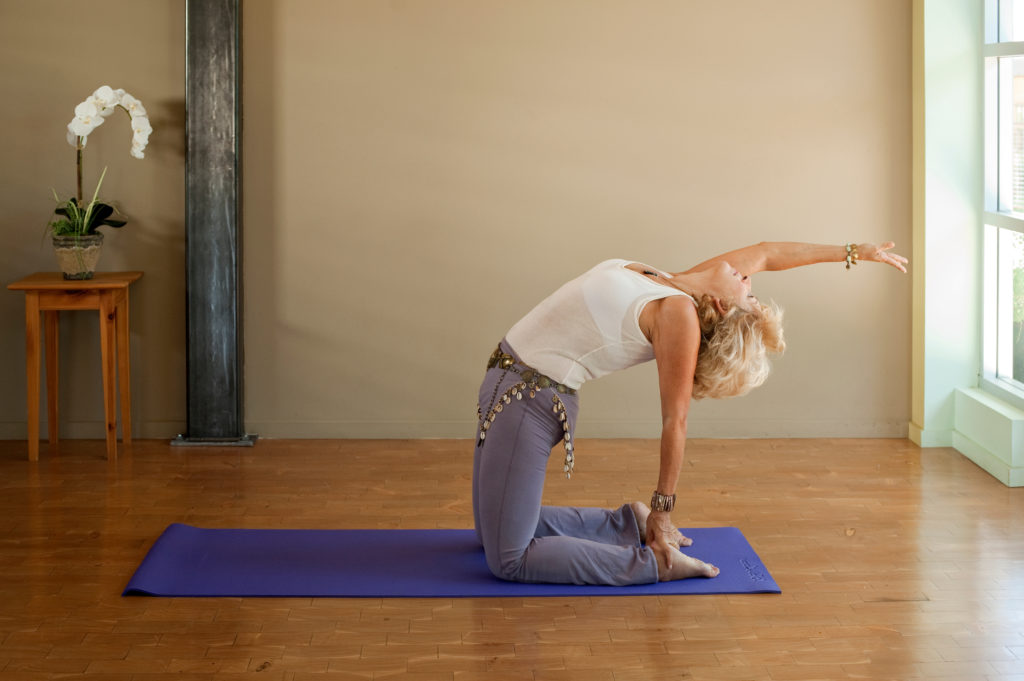Approximately 47 million women enter the menopausal transition each year with the world population of menopausal and postmenopausal women projected to increase to 1.2 billion by 2030 (1). Menopausal symptoms are highly prevalent and sufficiently bothersome to necessitate almost one-third of women to consult a doctor annually during the years of the menopausal transition (2).
With increasing numbers of women looking to explore complementary and alternative therapies for symptom management, yoga has become a progressively popular choice.

It certainly appears the yoga industry has caught on to this fact, with ‘Yoga for menopause’ classes, as well as courses and teacher trainings popping up everywhere. But what is the evidence that suggests yoga may be useful? And as teachers, how might we best support our menopausal students?
With the West ever keen to capitalize on the healing benefits of yoga, for me, when we begin ‘selling’ yoga as a treatment or cure for a specific symptom or condition, we walk a delicate line — we cross into a domain of increased responsibility. It’s important to be really clear with our students on what yoga may or may not be able to offer them in this regard and, if possible, why. It’s our duty to seek to obtain and understand the information available and communicate it honestly and openly in order to best serve our students.
What IS the Menopause?
Greek: Men (month) pausis (cessation). The menopause is a natural biological process in which the cessation of ovarian function marks the end of the reproductive phase of a woman’s life. This transition is not sudden and, for many women, is characterized by 5-8 years of symptoms ranging from mildly inconvenient or uncomfortable to significantly impairing their ability to function in day-to-day life (3).
The term menopause encompasses several stages: the first, perimenopause begins with the initial onset of menstrual irregularity with an average age of onset of 47, and culminates around 4 years later, 12 months after the final menstrual period, at which point a woman is considered to have entered the post-menopausal stage, (4). There is, however, substantial variability in the onset of these milestones and their associated symptomology (4).
What Really Are Menopausal Symptoms
Menopausal symptoms are varied and can be broadly grouped into several categories including vasomotor, urogenital, psychological and somatic symptoms.
Vasomotor symptoms including night sweats and hot flashes are incredibly prevalent, particularly among African American women and those with a higher BMI. Hot flashes can be moderately to severely problematic for up to a third of women – and can last from 1-2 years to 10 or more.
Urogenital symptoms including vaginal dryness are reported to occur in up to one-third of women. This may be accompanied by vaginal irritation, pain on urination (dysuria) and pain on intercourse (dyspareunia). Together these symptoms reflect the collective impact of a lack of oestrogen on the female genital tract and tend not to resolve without specific treatment.

Psychological symptoms including sleep difficulties, depressed mood, increased anxiety, and disturbances in cognition can also accompany the menopausal transition. The complex interplay between symptoms is often seen in which one may exacerbate another, for instance, hot flashes causing sleep disruption and thus low mood (4). Additional somatic symptoms include muscle and joint pain and fatigue (5).
This is by no means an exhaustive list and represents only the most commonly experienced symptoms. The experience of these symptoms and their severity can vary significantly from woman to woman and it serves us well to remember that for each woman, menopause is an experience personal and individual to her.
Why Yoga?
Although hormone replacement therapy can be highly effective in reducing menopausal symptoms, and has relatively low risk in the first 10 years of menopausal onset – long-standing uncertainty about its safety as well as a generalized contraindication in certain populations. This has resulted in increased interest in utilizing complementary and alternative therapies for symptom management — amongst the most popular of which is yoga (5).
Yoga certainly offers several advantages in terms of safety and potential supplementary health benefits, notably the potential for reducing the risk of cardiovascular disease and osteoporosis (6, 7). Risks and side-effects are generally minimal, and a broad range of populations can be embraced including the chronically ill and elderly. Perceived therapeutic benefit is also usually high (6).
What’s the Evidence?
A 2017 systematic review and meta-analysis of 13 Randomized Controlled Trials (RCTs), which included 1306 participants, evaluated the effects of yoga on menopausal symptoms. It concluded that yoga, when compared to no treatment, was safe and effective in reducing total menopausal symptoms, including psychological, somatic, vasomotor and urogenital symptoms (8).
Indeed, these findings are supported by a 2010 systematic review that identified 426 participants over 8 studies, including 5 Unrandomized Controlled Trials (UCTs) and 3 RCTs that evaluated the effects of yoga and meditation-based programs on the symptoms of menopause. This review concluded that there was modest evidence that yoga-based programs may be helpful in reducing common symptoms of menopause, including vasomotor, sleep, and mood disturbances, and that certain breath-based practices may be useful in reducing hot flashes (6).
One of the studies, a large RCT of 120 perimenopausal Indian women included in this review, evaluated the effects of yoga on cognitive changes associated with menopause. It demonstrated significant enhancement of both concentration and memory following a moderately intensive yoga program (9).

These findings contrast somewhat with a 2012 systematic review and meta-analysis of 4 RCTs, including 545 participants which found no evidence for improvement in total menopausal symptoms, somatic, vasomotor or urogenital symptoms.
It did however conclude that there was moderate evidence for short-term effectiveness of yoga for psychological symptom relief (e.g., depression, anxiety and sleep disturbance) in menopausal women, preliminarily recommending yoga as an adjunct intervention for women who suffer from psychological complaints associated with menopause. It should be noted however that it was not possible to evaluate which specific psychological symptoms were improved by yoga, neither was it possible to draw conclusions about long-term effectiveness.
On the specific subject of sleep, a 2020 systematic review and meta-analysis of 19 articles showed that while yoga may have a beneficial effect on improving sleep quality and insomnia, it has no significant effect on the peri/postmenopausal subgroup of women (10).
The effectiveness of yoga compared to other exercise interventions has not been convincingly substantiated (5), although a relative improvement in vasomotor symptoms has been suggested (8).
As is often the case, high variability in studies assessing the use of yoga as a treatment method makes drawing conclusions about efficacy difficult. There can be great heterogeneity in yoga practices with the intensity, frequency, and duration of yoga interventions varying considerably. There is a lack of long-term follow-up data and safety evaluation including serious adverse events or nonserious events in many of these studies. There is no doubt that more rigorous trials are required.
Why Might Yoga Help?
The mechanisms by which yoga and other mind-body practices might contribute to improved menopausal symptom control remain speculative. Additional, large, methodologically robust trials are required to investigate underlying mechanisms of action and potential benefits. It is widely accepted, however, that mind-body practices such as yoga cause a reduction in sympathetic activity and sympathoadrenal reactivity thereby increasing parasympathetic output. This has been hypothesized as the general mechanism behind the decreased prevalence of vasomotor and other common symptoms (6). Additionally, the proposed supplementary health benefits of yoga including weight reduction and management, improved mood, blood pressure reduction, and improved glucose tolerance and lipid profiles may in turn positively impact menopausal symptoms (6, 7). Similarly, yoga may lead to an improvement in several lifestyle factors linked to menopausal symptom severity such as smoking (11).
Additional, large, methodologically robust trials are required to investigate underlying mechanisms of action and potential benefits. It is widely accepted, however, that mind-body practices such as yoga cause a reduction in sympathetic activity and sympathoadrenal reactivity thereby increasing parasympathetic output. This has been hypothesized as the general mechanism behind the decreased prevalence of vasomotor and other common symptoms (6).
Additionally, the proposed supplementary health benefits of yoga including weight reduction and management, improved mood, blood pressure reduction, and improved glucose tolerance and lipid profiles may in turn positively impact menopausal symptoms (6, 7). Similarly, yoga may lead to an improvement in several lifestyle factors linked to menopausal symptom severity such as smoking (11).
The placebo effect, the belief or expectation that something might have an impact on the brain or body, is very powerful and having a positive perception of the outcome can really matter.
Therefore, if we believe yoga might be of benefit, there is a very real chance it might be. The placebo effect cannot be ruled out, but in many cases, yoga was compared to other plausible interventions including exercise and alternative relaxation practices, and sustained benefit post-intervention was seen, which might not be expected with a placebo effect (6).
Conclusion
The consensus from the compilation of research is that yoga has the potential to positively impact menopausal symptoms and overall wellbeing, with the possibility of ancillary health benefits. We can engage a wide range of populations in the practice, including the elderly, sedentary, chronically ill and those with larger BMIs with relatively low risk, which makes it an attractive complementary treatment modality. There is a need for large, methodologically robust trials to further investigate its potential benefits and explore in greater detail the sub-groups of women most likely to benefit.
Whilst yoga has a reputation for approaching well-being in a more holistic manner, by collectively grouping women experiencing a complex and varied life event under a single label of ‘menopause,’ we risk potentially failing to appreciate the uniqueness of their symptom experiences and individual needs. Just because women universally experience menopause, does not mean they experience it homogeneously.
As a physician, a key principle of clinical management would be to distinguish each woman’s individual symptom experience so that we can achieve maximal benefit in our treatment strategy. Whilst I’m not suggesting this is necessarily possible in a yoga context, an appreciation that yoga may not beneficially address all menopausal symptoms, or all menopausal symptoms equally, is important. Moreover, it’s our duty as yoga teachers to communicate that fact. There is likely to be significant variability between women — a woman who is already exercising regularly that struggles predominantly with menopause-related sleep disturbance, may not experience a significant benefit for example.

I think so long as we are open and transparent in this regard and acknowledge the role of pharmaceutical interventions such as Hormone Replacement Therapy (HRT), yoga has the potential to be a valuable treatment tool. It is also important to acknowledge that HRT is not the only pharmacological treatment option. While the risk-benefit of HRT is complex and unique to the individual, it is undeniable that it can be life-changing for many women and the role of modern medicine should not be discounted — but then, neither should yoga.
Lastly, although ‘yoga’ itself does not classically involve group discussion and interaction, attending a ‘yoga for menopause’ class or course provides the opportunity, (often if in a facilitated setting), for like-minded women to commune to discuss their concerns, experiences, and difficulties in a supportive group setting. That in itself offers a degree of healing potential. Often, emotional support, resource sharing, and signposting, as well as an exchange of experiential information, can be instrumental in positively impacting their ability to navigate this transition.
Sources
Hill K. The demography of menopause. Maturitas. 1996;23: 113-127. https://pubmed.ncbi.nlm.nih.gov/8735350/
Guthrie JR, Dennerstein L, Taffe JR, Donnelly V. Health care-seeking for menopausal problems. Climacteric. 2003 Jun;6(2):112-7. https://pubmed.ncbi.nlm.nih.gov/12841881/
Araujo, L. (2021). The 5 Beginner Yoga Poses That Everyone Needs to Know. The MAPS Institute. https://themapsinstitute.com/the-5-beginner-yoga-poses-that-everyone-needs-to-know/
Stojanovska L, Apostolopoulos V, Polman R, Borkoles E. To exercise, or, not to exercise, during menopause and beyond. Maturitas. 2014 Apr;77(4):318-23. doi: 10.1016/j.maturitas.2014.01.006. Epub 2014 Jan 24. https://pubmed.ncbi.nlm.nih.gov/24548848/
Santoro N. Perimenopause: From Research to Practice. J Womens Health (Larchmt). 2016 Apr;25(4):332-9. doi: 10.1089/jwh.2015.5556. Epub 2015 Dec 10. https://pubmed.ncbi.nlm.nih.gov/26653408/
Cramer H, Lauche R, Langhorst J, Dobos G. Effectiveness of yoga for menopausal symptoms: a systematic review and meta-analysis of randomized controlled trials. Evid Based Complement Alternat Med. 2012;2012:863905. https://pubmed.ncbi.nlm.nih.gov/23304220/
K. E. Innes, T. K. Selfe, and A. Vishnu, “Mind-body therapies for menopausal symptoms: a systematic review,” Maturitas, vol. 66, no. 2, pp. 135–149, 2010. https://www.ncbi.nlm.nih.gov/pmc/articles/PMC3031101/
Innes KE, Selfe TK, Taylor AG. Menopause, the metabolic syndrome, and mind-body therapies. Menopause. 2008 Sep-Oct;15(5):1005-13. https://pubmed.ncbi.nlm.nih.gov/18779682/
Cramer H, Peng W, Lauche R. Yoga for menopausal symptoms-A systematic review and meta-analysis. Maturitas. 2018 Mar;109:13-25. doi: 10.1016/j.maturitas.2017.12.005. Epub 2017 Dec 6. https://pubmed.ncbi.nlm.nih.gov/29452777/
Chattha R, Nagarathna R, Padmalatha V, Nagendra HR. Effect of yoga on cognitive functions in climacteric syndrome: a randomised control study. BJOG. 2008 Jul;115(8):991-1000. doi: 10.1111/j.1471-0528.2008.01749.x. Epub2008 May 22. https://pubmed.ncbi.nlm.nih.gov/18503578/
Wang WL, Chen KH, Pan YC, Yang SN, Chan YY. The effect of yoga on sleep quality and insomnia in women with sleep problems: a systematic review and meta-analysis. BMC Psychiatry. 2020;20(1):195. Published 2020 May 1. https://pubmed.ncbi.nlm.nih.gov/32357858/
Pérez JA, Garcia FC, Palacios S, Pérez M. Epidemiology of risk factors and symptoms associated with menopause in Spanish women. Maturitas. 2009 Jan 20;62(1):30-6. doi: 10.1016/j.maturitas.2008.10.003. Epub 2008 Nov 17. https://pubmed.ncbi.nlm.nih.gov/19010615/
Araujo, L. Introduction to Meditation. The MAPS Institute. https://themapsinstitute.com/introduction-to-meditation/
